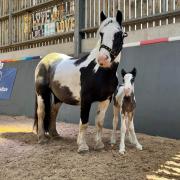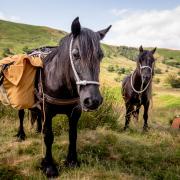Lynne Pew finds buried little treasures amid the mud of the River Irwell and transforms them into art

When Lynne Pew’s family see a pan simmering on the stove, they’ve learned not to foster high hopes for a delicious supper. It’s more than likely that it will contain pieces of Victorian pottery. That’s because Lynne, who lives in Ramsbottom, is a mudlark.
That’s the name for an amateur archaeologist who literally delves into muddy waters to retrieve what our ancestors threw away. Lynne is unusual though – she turns her finds into pieces of mosaic art that has fans across the world.
‘I didn’t actually know that there was an official term for what I did, until a few years ago, although it was originally used to describe paupers who had to scavenge for a living. I can tell you that my first reaction to the news was an overwhelming feeling of relief that I wasn’t bonkers after all,’ laughs Lynne.
It all began when Lynne, who has a degree in art, began taking her children Gabriel and Isabella for walks along the River Irwell. Pottering about on the edges, they would sometimes come across what looked like polished pebbles but, on closer inspection, turned out to be pieces of Victorian pottery that had been washed smooth by the water.

‘I’m notorious for trying to mend things,’ says Lynne. ‘If a plate or jug gets smashed in this house, then I’m there with the glue trying to mend it but, of course, in Victorian times and earlier, it wasn’t always so easy to do that and if rubbish couldn’t be burned, then it would often end up in the river. That’s what I was finding.’
Nowadays, she doesn’t just stay on the edges but dons her waders and, accompanied by golden retriever Alice, who must be the only mudlark dog in England, they collect fragments in an enamel bucket. Slipping is an occupational hazard – at least it is for Lynne, as Alice never topples over.
‘It’s a small price to pay because mudlarking is exciting and thought provoking. After all, there is a gap of at least a hundred years between the last person who handled a piece of pottery and me. Our Ramsbottom ancestors were very keen on blue and white patterns, as that’s the most common thing we find although Alice, whose hobby is chewing footwear, quite often retrieves millworkers’ ancient shoes,’ she laughs.
Lynne has also found several examples of Frozen Charlottes. These were tiny china dolls that Victorian housewives might slip into puddings instead of a silver coin when money was short, before economically re-using them as toys. Other objects include clay pipes, sold cheaply to millworkers, often complete with tobacco in the bowl and intended to be discarded after one use.

‘It’s rare to find whole pieces, as the Irwell is very rocky, unlike say the Thames where things sink gently into the mud in one piece. Here, many items are broken but that’s what gave me the idea for turning fragments into mosaic art. I’m recycling part of Lancashire’s domestic history into something beautiful,’ says Lynne.
So is that where the pan simmering on the hob comes in? ‘Of course! No matter how pretty the pieces Alice and I collect, you do have to remember that they have come out of the Irwell, where they’ve lain in mud for over a century. First of all, I put them in a pail of rainwater, then I transfer them to another with some bleach in it and then, just to be extra sure, I gently boil them. It’s pottery soup but my husband and two hungry teenagers haven’t yet been tempted to try it...well, not as far as I know!’
She then sorts out the mosaic pieces by colour and shape and begins to form them into unique little works of art. ‘Luckily, I’m patient with a trained eye for colour. I love jigsaws too, which is a help but that said, I do use a glue that gives me a bit of leeway before it sets.’
So pretty are the finished pieces that she won a competition to showcase them in London. It was a success and gained her several commissions and enquiries from outlets who wanted to stock them.

‘I had no idea they would be so popular but it seems lots of people share my fascination for bringing social history back to life in this way,’ she says.
Today, Lynne does provide some stock to interior design shops but she mostly works to commission, with people who want a piece of Lancashire history as art. Through her website, they get in touch from all around the world, including America.
‘Initials are popular, especially for weddings and births but I’m happy to discuss other ideas. Sometimes though, the pieces that I find suggest a design, either by their shape or pattern. A good example of that are my Mudlark Bees. The Irwell has some black and white fragments, such as lettering from stone jars that had contained food or drink and they can look like stripes. One of these pieces had a gently curved bottom, which really put me in mind of a bee. So, I made one, using vintage music sheets for wings and finished it off with a little freehand drawing,’ she explains.
It wasn’t long before they were being snapped up and the Manchester Beekeepers’ Association, who are based in The Dower House in Heaton Park, were so impressed that they have hung some on their walls – a real buzz for Lynne, a mudlark for whom the mud of the Irwell has certainly proved glorious!


Not such a lark
The original mudlarks were Dickensian characters who scavenged in river mud for items of value, particularly in London during the late 18th and 19th centuries.
They were usually poverty-stricken children who scraped a living by searching at low tide for anything that could be sold. Conditions were appalling as raw sewage was pumped into rivers and ‘finds’ could also include the corpses of humans, cats and dogs. They often suffered cuts from broken glass.
By the 1930s the term was used to describe swimsuited London schoolchildren earning pocket money during the summer holidays by begging passers-by to throw coins into the Thames mud, which they then chased, to the amusement of the onlookers.





























